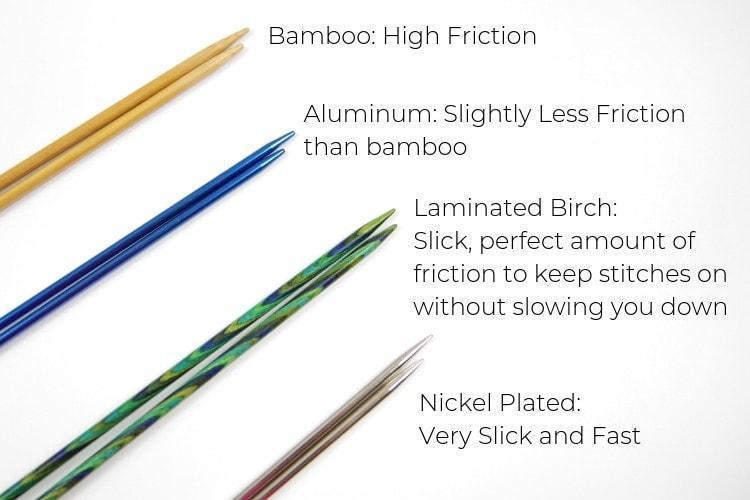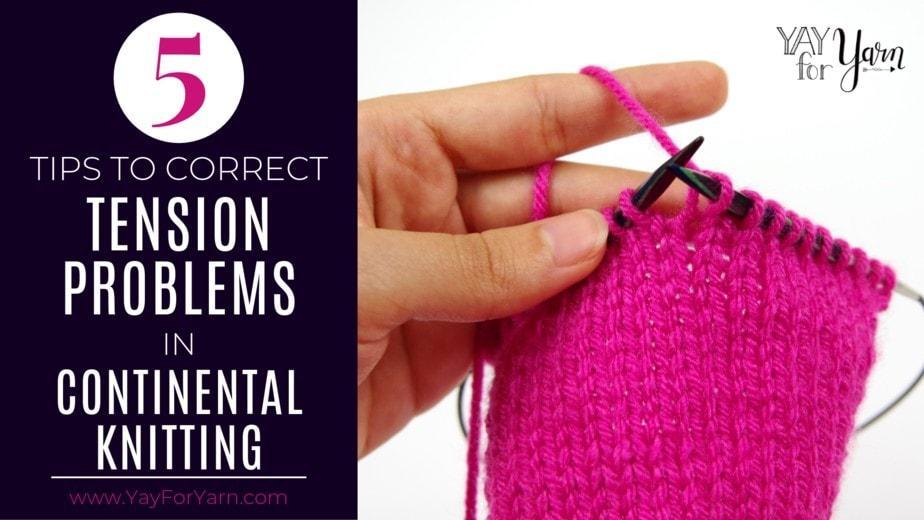Have you ever had problems with tension in Continental Knitting? Try these 5 tips to fix your tension now!
If you’ve seen my tutorial on Continental Knitting, you know that it’s my absolute favorite way to knit. It’s faster and more efficient than most other styles, once you get the hang of it.
However, when you’re learning Continental Knitting, it’s common to have tension problems. After all, if you’re switching from English style to Continental, you’re holding the yarn in the opposite hand, which changes many of the movements required to make a stitch. Fortunately, tension problems can be corrected with a few simple tricks.
Let’s start by understanding tension.
Tension is how tightly or loosely you knit. We create tension on the yarn by wrapping it around or through our fingers. The yarn should glide smoothly through, and the stitches should be able to slide smoothly across the needle. When the tension is correct, you will naturally produce consistent, even stitches.
If the yarn is too tight, the stitches will also be too tight, and require you to force the needle in and out of the stitches or force the stitches along the needle.
If the yarn is too loose, the stitches can be too loose or uneven. You may have trouble controlling or picking up the yarn with your needle tip, and stitches may be prone to falling off the needle.
So here are my 5 best tips for correcting tension problems in Continental Knitting:
Tip #1. Change the way you wrap the yarn through the fingers of your left hand.
The way you wrap the yarn through your fingers has a lot of effect on the tension you’re putting on the yarn. There are many different ways to tension the yarn, and there is no “wrong way” to do it (as long as the yarn comes over the top of the index finger). However, some knitters may have trouble with certain tension methods causing them to knit too loosely or too tightly. So, it is important to find a tension method that works best for you.
Each time the yarn is wrapped around a finger, that puts more tension on the yarn (making tighter stitches).
If you knit loosely, you may need to wrap the yarn around one of your fingers to add more tension. If you already have the yarn wrapped around one of your fingers, and you still knit very loosely, you may need to wrap the yarn around another finger to add more tension to the yarn.
For tight knitters, if you already have the yarn wrapped around one finger, you may need to try a different method that does not wrap the yarn around any of your fingers.
Here are 5 ways to hold the yarn for Continental Knitting:
Hold #1:
With left palm facing up, wrap the yarn coming from the knitting around the pinky finger, behind the next three fingers, and over the top of the index finger. This method is commonly used for Continental Knitting.

Hold #2:
With left palm facing up, wrap the yarn coming from the knitting around the index finger towards you twice, so it comes over the top of the index finger to the knitting. This method may work well for loose knitters.

Hold #3
With left palm facing down, wrap the yarn coming from the knitting away from you across the back of the left hand. Bring the yarn towards you under the pinky finger and across the top of the next three fingers. The yarn should come over top of the index finger towards the knitting. This method is good for tight knitters, as it does not put a lot of tension on the yarn.

Hold #4
With left palm facing down, wrap the yarn coming from the knitting towards you across your left wrist. Bring the yarn away from you under the palm of the left hand, and towards you over the fingers of the left hand. Yarn should come over the top of the index finger towards the knitting. This method is also good for tight knitters, as it does not put a lot of tension on the yarn.

Hold #5
With left palm facing up, bring the yarn coming from the knitting over the pinky finger, under the ring finger, over the middle finger, and under the index finger. When the left hand is holding the left needle, the yarn should come over top of the left index finger towards the knitting. This is my favorite method, and the one I always use. It creates just the right amount of tension for me. I can make very slight adjustments in the tension if necessary by slightly spreading my fingers (to loosen) or bringing them closer together (to tighten).

Tip #2. Make sure the tip of the left index finger is close to the needles.
This tip is extra-important for loose knitters. If you’ve already added more tension to the yarn and still have loose stitches, you may be holding the left index finger too high. When the left index finger is held straight up, there is more length in the yarn to allow that finger to relax a little. Even a little variation in the position of that finger can add extra slack in the yarn that runs from the index finger to the knitting. When that yarn droops a little, it can be much harder to grab the yarn with the needle tip.
For maximum efficiency and proper tension, the left index finger should be held close to the needle tips. This position is more natural for the hand. Since there isn’t as much length in the yarn running from the index finger to the knitting, the index finger does not have much room to vary in its position. So, the yarn will not have extra slack in it, and it will be easier to grab the yarn with the needle tip.

Tip #3. Change the type of needles you are using.
Needles made from different materials have different amounts of surface friction. Bamboo is one of the grippiest materials, (more friction). If you are a tighter knitter, bamboo needles can make the stitches slide more slowly. However, if you are a looser knitter, bamboo may work well for you since the extra friction can help keep loose stitches on the needle. Slippery yarns are often easier to work with on bamboo needles because of that extra friction. Aluminum needles have slightly less friction than bamboo, but they are still a somewhat high-friction material.
Slicker materials, such as nickel plated needles, have very little surface friction, allowing the stitches to glide quickly and smoothly across. If you are a looser knitter, a slick needle may make it harder to keep from dropping stitches, as the stitches are already loose, and they are on a slick surface. There isn’t enough surface friction to keep the stitches on the needle. If you are a tighter knitter, a slick needle may help to even out your tension. If you find yourself forcing the needles in and out of the stitches, it may be because your high-friction needles do not allow your tight stitches to move easily, making it harder to get the needle into the stitch.
Once you have found a tension method that works well for you, and your tension is even and consistent, you may be able to use any type of knitting needle without tension problems. I like the speed of the slicker nickel plated or laminated birch needles, but I can also knit with bamboo or aluminum without tension problems.

Tip #4. Wind your yarn into a center-pull skein.
Uneven tension can be caused by the way your yarn is wound. If the yarn is hand-wound into a ball and you are not using a yarn bowl or other container to keep it in one place, it can feed unevenly as it rolls around the floor. For more even feeding, wind the yarn into a center-pull skein using a yarn winder. If your yarn comes in a hank, you’ll also need a yarn swift. Or, you can use the center-pull end of a pre-wound skein.

Tip #5. Make sure you are working your stitches on the straight part of the needle.
Some people may knit tighter because they are working stitches on the wrong section of the needle. With Continental knitting, it is most efficient to keep the stitches close to the needle tips. However, if you are working through your stitches on the tapered section of the needle tip, that can cause the stitches to be tight.
The stitches are supposed to fit comfortably around the circumference of the needle. If you are working your stitches on the tapered tip, the stitches are only made to fit comfortably around the tapered section instead of the straight part of the needle. It’s best to keep the stitches on the straight part of the needle while working them, instead of working through them on the tapered needle tips.

If you’re having trouble with your tension, I hope you’ll give some of these tips a try! Sometimes a simple change can make a huge difference in the look and feel of your knitting. Once you’ve got even, consistent tension, your projects will look neater and more professional, and you’ll feel more confident in your Continental Knitting skills.
Have you tried Continental Knitting yet?
Pin the image below to save these tips for later!








I was a knitter for years but got frustrated when all the yarn shops in my town closed and there was nowhere to get help with mistakes I cannot read or fix. Stopped yarning for several years but recently learned crochet off You Tube. I find I still have tension problems and a very awkward way of holding yarn that needs constant adjustment. Like my knitting very tight tension in crochet. Your information is so thorough and informative. I hope your tips help me become a more proficient and relaxed crocheter. Thank you, Leslie
I started with crocheting several years ago. I only picked it up again about a year ago. Relearning to crochet has been easier than learning to knit. Tension has always been an issue for me, even with crochet. I could never figure out the, what I call, glide hold. Where the yarn just glides thru your fingers and on to your hook or needles. Despite the constant frustration of feeling awkward with my yarn I kept trying. I thought eventually my hands would just figure it out. And then one day, the heavens opened up and shined down upon me and I was introduced to the Tension Regulator. It’s hardly talked about and when it is talked about it’s referred to as a “beginners tool” much like training wheels for a bike. And I’m not sure why!
This was a game changer for me! Both for crochet and my attempts at knitting. I crocheted a couple regulators up, one for thinner yarn and one for thicker yarn. For my birthday this year my husband got me a pack of 8 regulator rings. I’m never without a regulator. Honestly, I can’t see myself not using one. It helps my hands and fingers relax therefor all the muscles from my fingers to my neck and back are more relaxed. My anxiety is gone because I’m not constantly second guessing my tension. My stitches are more uniform and my projects look better. Win-Win!
I am so thankful to your for your continental knitting tension problems. I have struggled for years off and on with continental knitting.
You taught me that I was holding the needles too far apart. I practiced your tension lessons and my stitches look so “Beautiful”. THANK YOU!!!
Hi,
I am just switching from English knitting to Continental knitting and loved your cheat sheets. But I am having trouble with tension. So I just read the tension tips, which are fantastic. But, my particular problem was not dealt with. I hope you can address it for me – and maybe for
“switchers.,” Th problem is when I pull the yarn through the stitch I am knitting, then the yearn comes off my index finger and the length increases. I have to rewind it around my index finger after every stitch. If this makes sense and you have advice, let me know. I could probably take a picture of what it looks like after the stitch, if that would help. This advice might help other “switchers” as well.
Thanks,
Susan
Hi Susan! If the yarn is falling off of your index finger, you may have it running a little too close to the fingertip, or it may be too tight. The yarn should be able to glide smoothly through the fingers without getting stuck. Try wrapping the yarn however you have been doing it, and pull on the working yarn to see how it glides. If it does not flow smoothly, you might want to try a different way of tensioning the yarn. If it does flow smoothly, then you might try wrapping it a little further from the fingertip, or changing the angle of your hands as you pull the stitch through so the yarn does not get pulled off of your finger. I hope this helps!
I never knew there was a continental Way have knitting I had a friend who use to tuck the left hand needle under her arm , I can’t wait to have a go been knitting for years but not a fast knitter thanks for the video and the sheet continental knitting here I come
Hi,
Thanks for the great tips.
Was excited to see you had a cheat sheet with your you tube video – sadly the link received with the sign up email does not work? – can’t connect to the server at el2convertkit-mail.com
Would it be possible to get a resend with working link.
Hi Kim. I received your email letting me know about this error a couple days ago, and I have let my email service provider know about it. They are working to get that fixed. However, I did reply to your original email, and resent you the cheat sheet. I’m sorry if it did not come through. Could you try checking your spam or junk folder?
Also, perhaps you could try opening the link in the original email in a different browser. In testing this error, I have found that the link works for me in Google Chrome, but not in Firefox. What browser are you using to open the link?
Thanks!
Hi Brianna,
Thank you so much for your quick response! I did find your email in my spam (would have never looked sorry).
Just fyi, I was using Firefox but did not get the link to work in Google Chrome either.
Thanks again for your help and everything you do, you are the best!
You’re welcome! Happy Yarning!
Want the cheat sheet for continental knitting
Hi Nancy! If you want to get the free cheat sheet, you can get it by signing up for my email list on this page. I hope this helps!
Looking for knitting patterns for babies
Hi Margaret! I have not designed any knitting patterns for babies, but I do have a Pinterest board of baby knitting patterns here. Another great place to find patterns is Ravelry. It is a free-to-join site where you can find multitudes of patterns. Some are free, some are instant downloads, and some are listings for patterns published in books or magazines. The search filters can help you narrow down your search to find exactly what you are looking for. Hope this helps!